BSBMKG608: Strategic Marketing Objectives Development for A&A Coffee
VerifiedAdded on 2023/04/21
|23
|5324
|388
Report
AI Summary
This report provides a comprehensive analysis of A&A Coffee's strategic marketing objectives, addressing various aspects such as the company's mission, strategic direction, and targets. It includes a situational analysis, legal and ethical considerations, and a review of past marketing performance. The report also scopes marketing opportunities using SWOT analysis, formulates long and short-range objectives, considers risk management strategies, and documents the marketing objectives. The assessment covers financial management techniques, relevant legislation, regulatory bodies, and marketing evaluation techniques, offering a detailed understanding of the marketing landscape and strategic planning for A&A Coffee. This document is available on Desklib, a platform offering a variety of study resources and AI-powered tools for students.
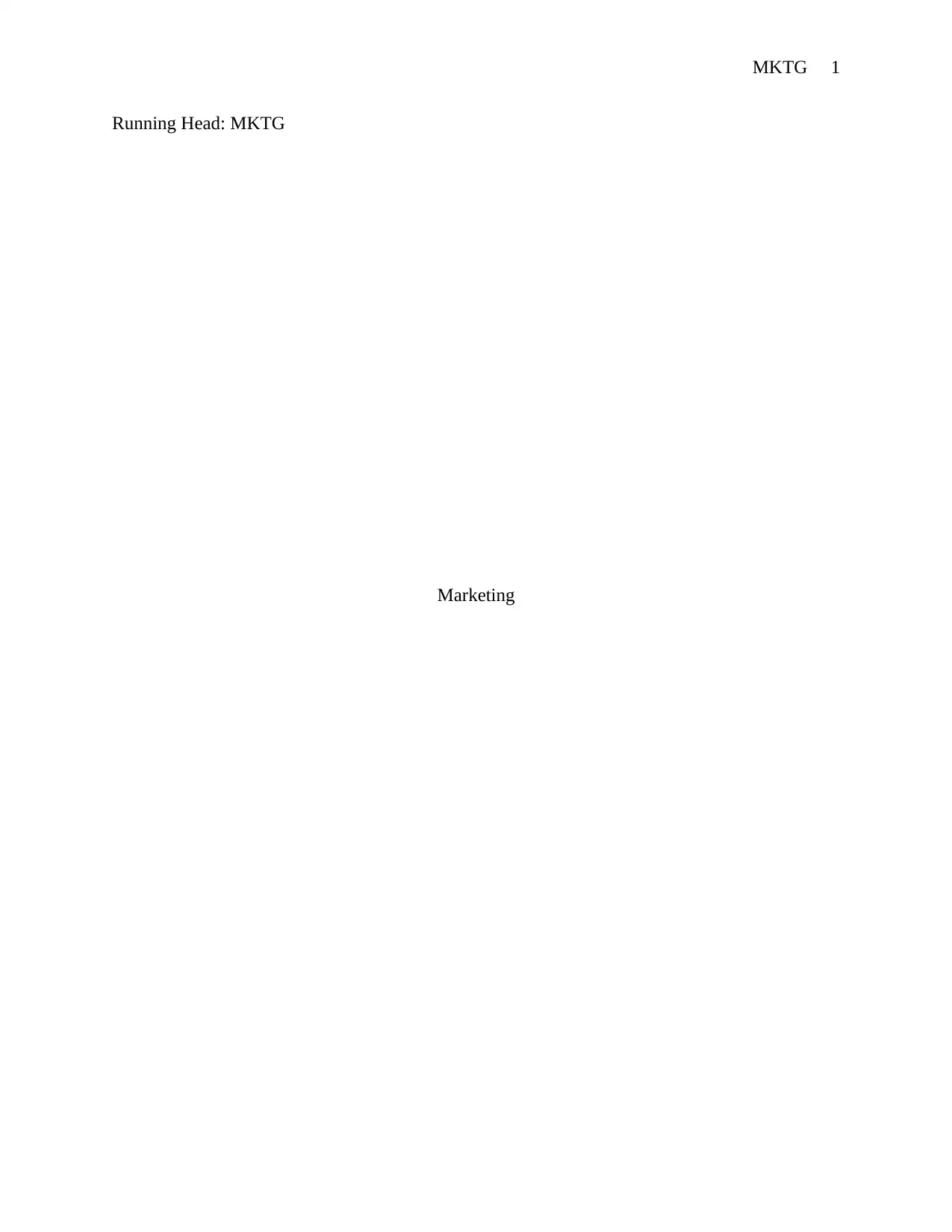
MKTG 1
Running Head: MKTG
Marketing
Running Head: MKTG
Marketing
Paraphrase This Document
Need a fresh take? Get an instant paraphrase of this document with our AI Paraphraser
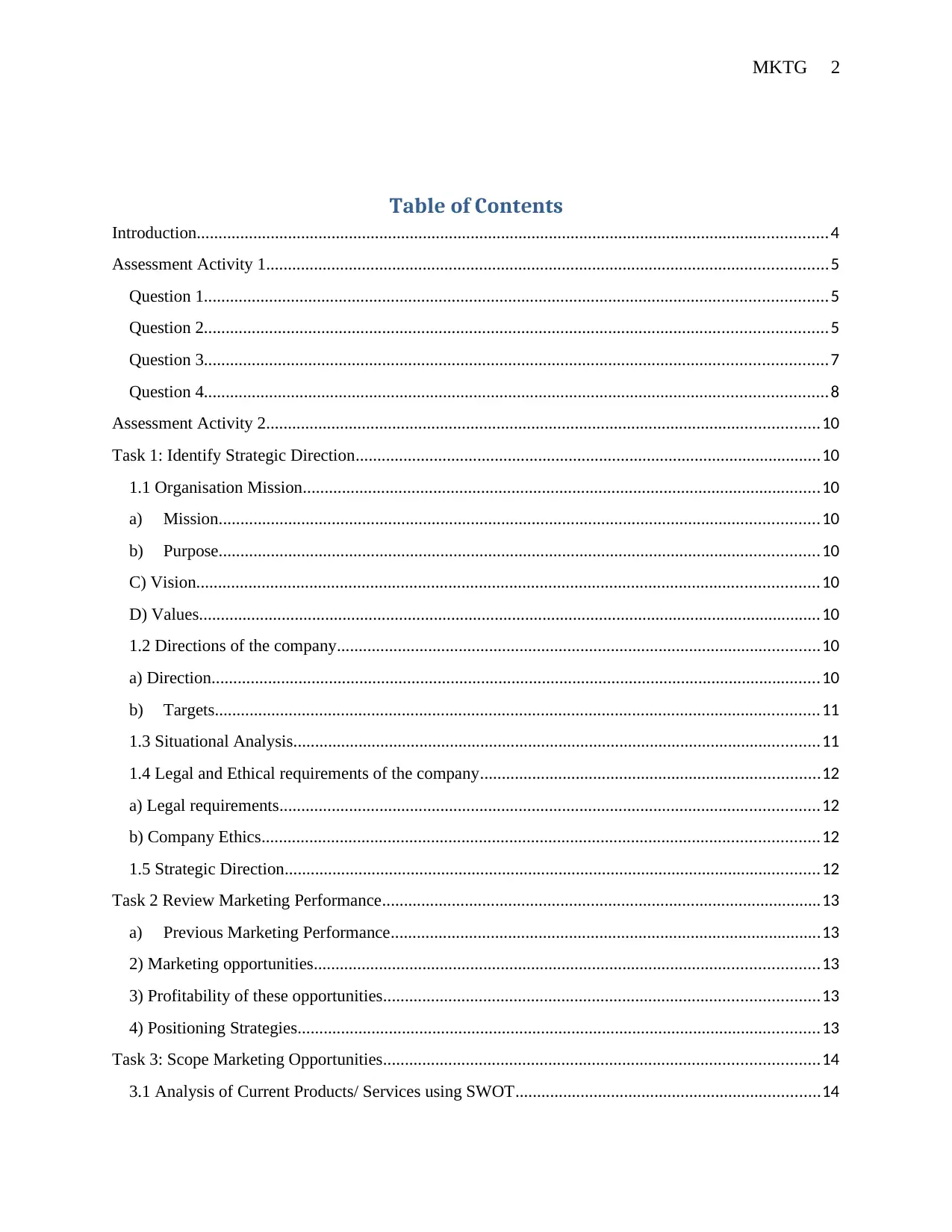
MKTG 2
Table of Contents
Introduction.................................................................................................................................................4
Assessment Activity 1.................................................................................................................................5
Question 1...............................................................................................................................................5
Question 2...............................................................................................................................................5
Question 3...............................................................................................................................................7
Question 4...............................................................................................................................................8
Assessment Activity 2...............................................................................................................................10
Task 1: Identify Strategic Direction...........................................................................................................10
1.1 Organisation Mission.......................................................................................................................10
a) Mission..........................................................................................................................................10
b) Purpose..........................................................................................................................................10
C) Vision...............................................................................................................................................10
D) Values...............................................................................................................................................10
1.2 Directions of the company...............................................................................................................10
a) Direction............................................................................................................................................10
b) Targets...........................................................................................................................................11
1.3 Situational Analysis.........................................................................................................................11
1.4 Legal and Ethical requirements of the company..............................................................................12
a) Legal requirements............................................................................................................................12
b) Company Ethics................................................................................................................................12
1.5 Strategic Direction...........................................................................................................................12
Task 2 Review Marketing Performance.....................................................................................................13
a) Previous Marketing Performance...................................................................................................13
2) Marketing opportunities....................................................................................................................13
3) Profitability of these opportunities....................................................................................................13
4) Positioning Strategies........................................................................................................................13
Task 3: Scope Marketing Opportunities....................................................................................................14
3.1 Analysis of Current Products/ Services using SWOT......................................................................14
Table of Contents
Introduction.................................................................................................................................................4
Assessment Activity 1.................................................................................................................................5
Question 1...............................................................................................................................................5
Question 2...............................................................................................................................................5
Question 3...............................................................................................................................................7
Question 4...............................................................................................................................................8
Assessment Activity 2...............................................................................................................................10
Task 1: Identify Strategic Direction...........................................................................................................10
1.1 Organisation Mission.......................................................................................................................10
a) Mission..........................................................................................................................................10
b) Purpose..........................................................................................................................................10
C) Vision...............................................................................................................................................10
D) Values...............................................................................................................................................10
1.2 Directions of the company...............................................................................................................10
a) Direction............................................................................................................................................10
b) Targets...........................................................................................................................................11
1.3 Situational Analysis.........................................................................................................................11
1.4 Legal and Ethical requirements of the company..............................................................................12
a) Legal requirements............................................................................................................................12
b) Company Ethics................................................................................................................................12
1.5 Strategic Direction...........................................................................................................................12
Task 2 Review Marketing Performance.....................................................................................................13
a) Previous Marketing Performance...................................................................................................13
2) Marketing opportunities....................................................................................................................13
3) Profitability of these opportunities....................................................................................................13
4) Positioning Strategies........................................................................................................................13
Task 3: Scope Marketing Opportunities....................................................................................................14
3.1 Analysis of Current Products/ Services using SWOT......................................................................14
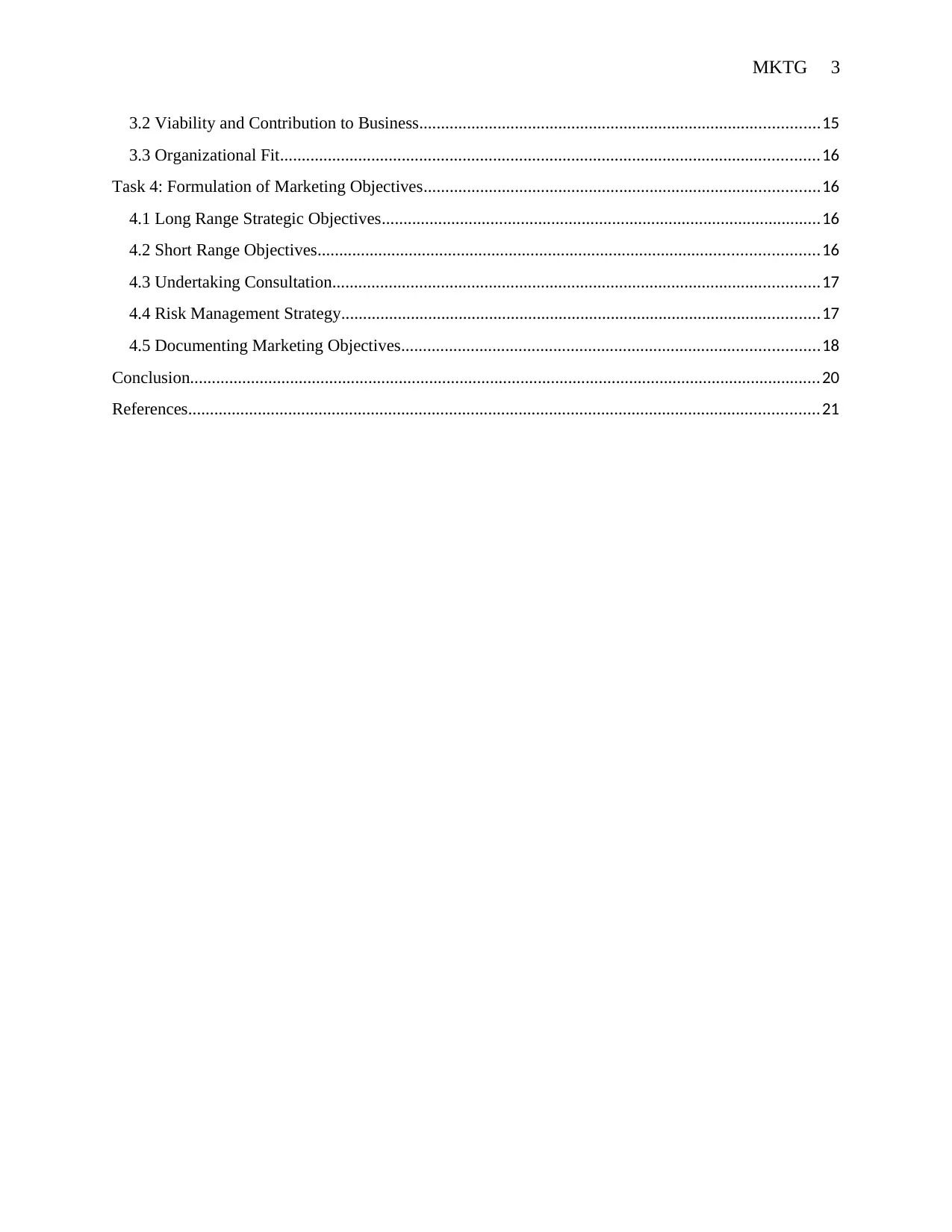
MKTG 3
3.2 Viability and Contribution to Business............................................................................................15
3.3 Organizational Fit............................................................................................................................16
Task 4: Formulation of Marketing Objectives...........................................................................................16
4.1 Long Range Strategic Objectives.....................................................................................................16
4.2 Short Range Objectives...................................................................................................................16
4.3 Undertaking Consultation................................................................................................................17
4.4 Risk Management Strategy..............................................................................................................17
4.5 Documenting Marketing Objectives................................................................................................18
Conclusion.................................................................................................................................................20
References.................................................................................................................................................21
3.2 Viability and Contribution to Business............................................................................................15
3.3 Organizational Fit............................................................................................................................16
Task 4: Formulation of Marketing Objectives...........................................................................................16
4.1 Long Range Strategic Objectives.....................................................................................................16
4.2 Short Range Objectives...................................................................................................................16
4.3 Undertaking Consultation................................................................................................................17
4.4 Risk Management Strategy..............................................................................................................17
4.5 Documenting Marketing Objectives................................................................................................18
Conclusion.................................................................................................................................................20
References.................................................................................................................................................21
⊘ This is a preview!⊘
Do you want full access?
Subscribe today to unlock all pages.

Trusted by 1+ million students worldwide
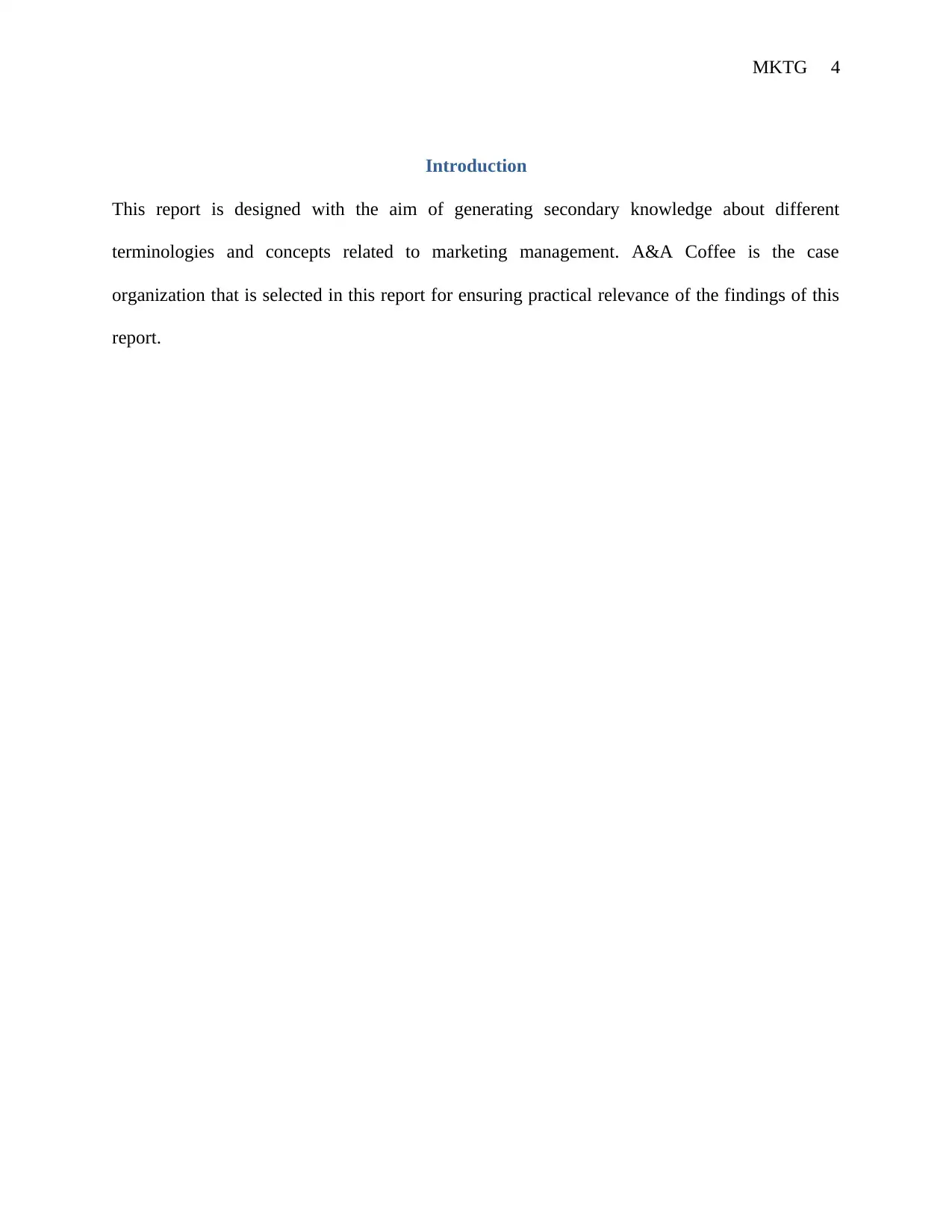
MKTG 4
Introduction
This report is designed with the aim of generating secondary knowledge about different
terminologies and concepts related to marketing management. A&A Coffee is the case
organization that is selected in this report for ensuring practical relevance of the findings of this
report.
Introduction
This report is designed with the aim of generating secondary knowledge about different
terminologies and concepts related to marketing management. A&A Coffee is the case
organization that is selected in this report for ensuring practical relevance of the findings of this
report.
Paraphrase This Document
Need a fresh take? Get an instant paraphrase of this document with our AI Paraphraser
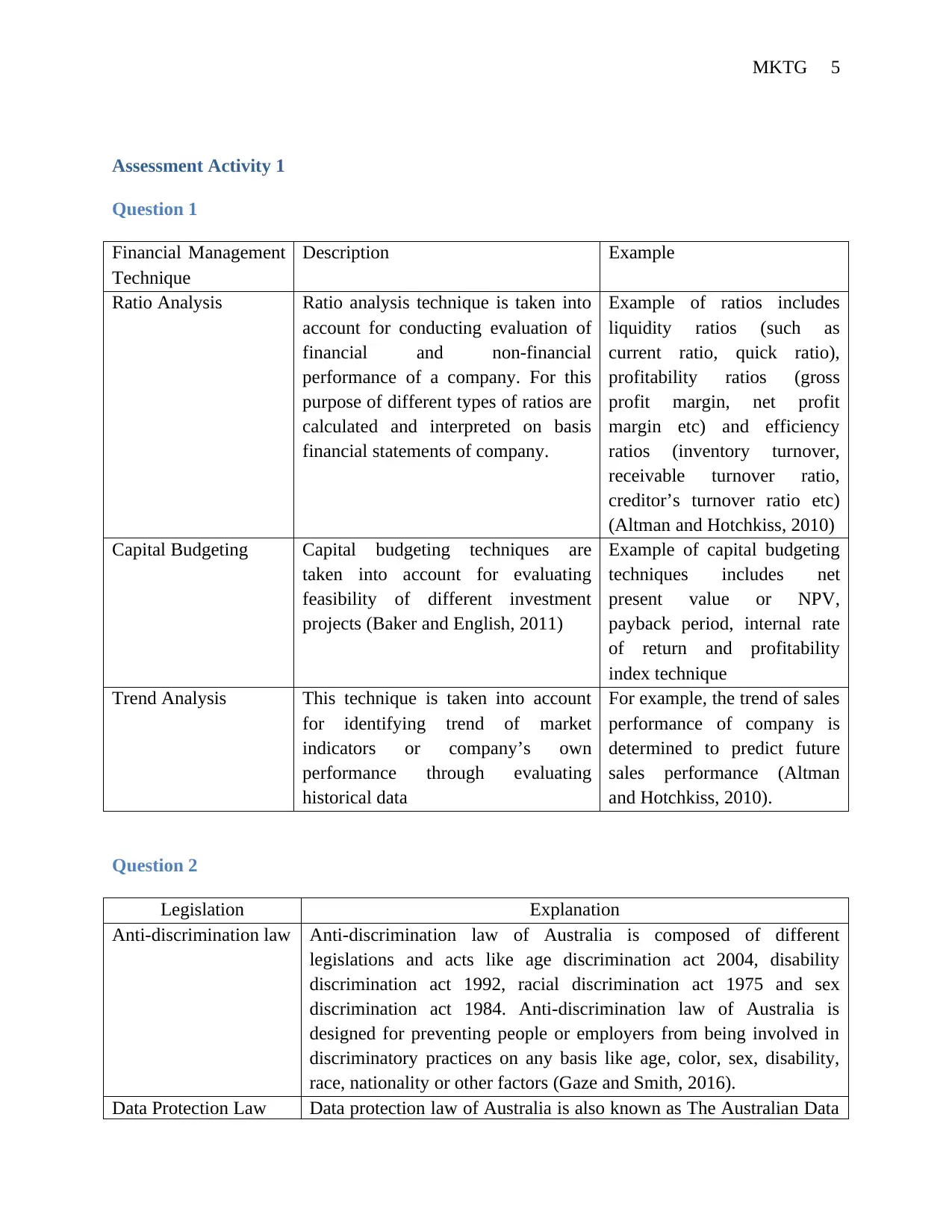
MKTG 5
Assessment Activity 1
Question 1
Financial Management
Technique
Description Example
Ratio Analysis Ratio analysis technique is taken into
account for conducting evaluation of
financial and non-financial
performance of a company. For this
purpose of different types of ratios are
calculated and interpreted on basis
financial statements of company.
Example of ratios includes
liquidity ratios (such as
current ratio, quick ratio),
profitability ratios (gross
profit margin, net profit
margin etc) and efficiency
ratios (inventory turnover,
receivable turnover ratio,
creditor’s turnover ratio etc)
(Altman and Hotchkiss, 2010)
Capital Budgeting Capital budgeting techniques are
taken into account for evaluating
feasibility of different investment
projects (Baker and English, 2011)
Example of capital budgeting
techniques includes net
present value or NPV,
payback period, internal rate
of return and profitability
index technique
Trend Analysis This technique is taken into account
for identifying trend of market
indicators or company’s own
performance through evaluating
historical data
For example, the trend of sales
performance of company is
determined to predict future
sales performance (Altman
and Hotchkiss, 2010).
Question 2
Legislation Explanation
Anti-discrimination law Anti-discrimination law of Australia is composed of different
legislations and acts like age discrimination act 2004, disability
discrimination act 1992, racial discrimination act 1975 and sex
discrimination act 1984. Anti-discrimination law of Australia is
designed for preventing people or employers from being involved in
discriminatory practices on any basis like age, color, sex, disability,
race, nationality or other factors (Gaze and Smith, 2016).
Data Protection Law Data protection law of Australia is also known as The Australian Data
Assessment Activity 1
Question 1
Financial Management
Technique
Description Example
Ratio Analysis Ratio analysis technique is taken into
account for conducting evaluation of
financial and non-financial
performance of a company. For this
purpose of different types of ratios are
calculated and interpreted on basis
financial statements of company.
Example of ratios includes
liquidity ratios (such as
current ratio, quick ratio),
profitability ratios (gross
profit margin, net profit
margin etc) and efficiency
ratios (inventory turnover,
receivable turnover ratio,
creditor’s turnover ratio etc)
(Altman and Hotchkiss, 2010)
Capital Budgeting Capital budgeting techniques are
taken into account for evaluating
feasibility of different investment
projects (Baker and English, 2011)
Example of capital budgeting
techniques includes net
present value or NPV,
payback period, internal rate
of return and profitability
index technique
Trend Analysis This technique is taken into account
for identifying trend of market
indicators or company’s own
performance through evaluating
historical data
For example, the trend of sales
performance of company is
determined to predict future
sales performance (Altman
and Hotchkiss, 2010).
Question 2
Legislation Explanation
Anti-discrimination law Anti-discrimination law of Australia is composed of different
legislations and acts like age discrimination act 2004, disability
discrimination act 1992, racial discrimination act 1975 and sex
discrimination act 1984. Anti-discrimination law of Australia is
designed for preventing people or employers from being involved in
discriminatory practices on any basis like age, color, sex, disability,
race, nationality or other factors (Gaze and Smith, 2016).
Data Protection Law Data protection law of Australia is also known as The Australian Data
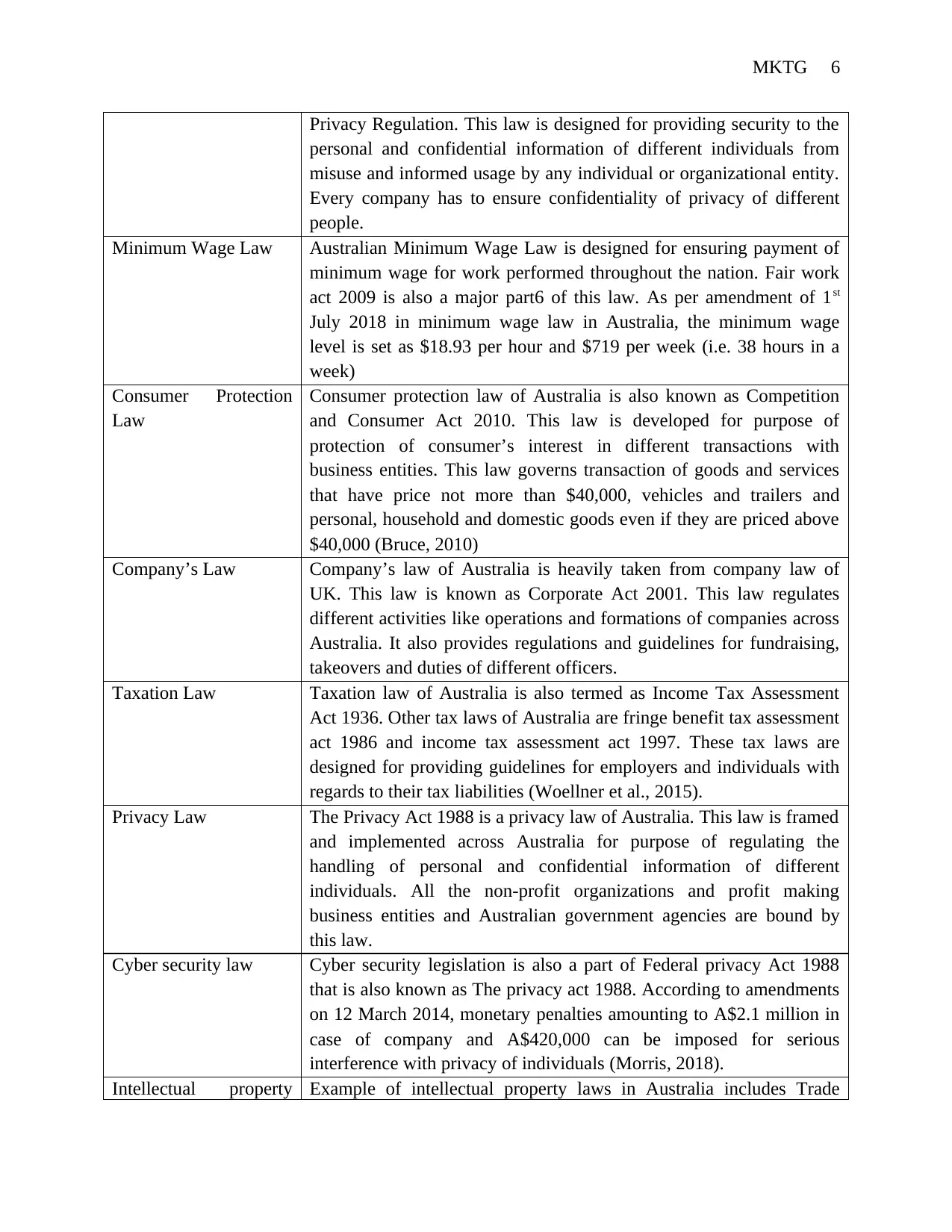
MKTG 6
Privacy Regulation. This law is designed for providing security to the
personal and confidential information of different individuals from
misuse and informed usage by any individual or organizational entity.
Every company has to ensure confidentiality of privacy of different
people.
Minimum Wage Law Australian Minimum Wage Law is designed for ensuring payment of
minimum wage for work performed throughout the nation. Fair work
act 2009 is also a major part6 of this law. As per amendment of 1st
July 2018 in minimum wage law in Australia, the minimum wage
level is set as $18.93 per hour and $719 per week (i.e. 38 hours in a
week)
Consumer Protection
Law
Consumer protection law of Australia is also known as Competition
and Consumer Act 2010. This law is developed for purpose of
protection of consumer’s interest in different transactions with
business entities. This law governs transaction of goods and services
that have price not more than $40,000, vehicles and trailers and
personal, household and domestic goods even if they are priced above
$40,000 (Bruce, 2010)
Company’s Law Company’s law of Australia is heavily taken from company law of
UK. This law is known as Corporate Act 2001. This law regulates
different activities like operations and formations of companies across
Australia. It also provides regulations and guidelines for fundraising,
takeovers and duties of different officers.
Taxation Law Taxation law of Australia is also termed as Income Tax Assessment
Act 1936. Other tax laws of Australia are fringe benefit tax assessment
act 1986 and income tax assessment act 1997. These tax laws are
designed for providing guidelines for employers and individuals with
regards to their tax liabilities (Woellner et al., 2015).
Privacy Law The Privacy Act 1988 is a privacy law of Australia. This law is framed
and implemented across Australia for purpose of regulating the
handling of personal and confidential information of different
individuals. All the non-profit organizations and profit making
business entities and Australian government agencies are bound by
this law.
Cyber security law Cyber security legislation is also a part of Federal privacy Act 1988
that is also known as The privacy act 1988. According to amendments
on 12 March 2014, monetary penalties amounting to A$2.1 million in
case of company and A$420,000 can be imposed for serious
interference with privacy of individuals (Morris, 2018).
Intellectual property Example of intellectual property laws in Australia includes Trade
Privacy Regulation. This law is designed for providing security to the
personal and confidential information of different individuals from
misuse and informed usage by any individual or organizational entity.
Every company has to ensure confidentiality of privacy of different
people.
Minimum Wage Law Australian Minimum Wage Law is designed for ensuring payment of
minimum wage for work performed throughout the nation. Fair work
act 2009 is also a major part6 of this law. As per amendment of 1st
July 2018 in minimum wage law in Australia, the minimum wage
level is set as $18.93 per hour and $719 per week (i.e. 38 hours in a
week)
Consumer Protection
Law
Consumer protection law of Australia is also known as Competition
and Consumer Act 2010. This law is developed for purpose of
protection of consumer’s interest in different transactions with
business entities. This law governs transaction of goods and services
that have price not more than $40,000, vehicles and trailers and
personal, household and domestic goods even if they are priced above
$40,000 (Bruce, 2010)
Company’s Law Company’s law of Australia is heavily taken from company law of
UK. This law is known as Corporate Act 2001. This law regulates
different activities like operations and formations of companies across
Australia. It also provides regulations and guidelines for fundraising,
takeovers and duties of different officers.
Taxation Law Taxation law of Australia is also termed as Income Tax Assessment
Act 1936. Other tax laws of Australia are fringe benefit tax assessment
act 1986 and income tax assessment act 1997. These tax laws are
designed for providing guidelines for employers and individuals with
regards to their tax liabilities (Woellner et al., 2015).
Privacy Law The Privacy Act 1988 is a privacy law of Australia. This law is framed
and implemented across Australia for purpose of regulating the
handling of personal and confidential information of different
individuals. All the non-profit organizations and profit making
business entities and Australian government agencies are bound by
this law.
Cyber security law Cyber security legislation is also a part of Federal privacy Act 1988
that is also known as The privacy act 1988. According to amendments
on 12 March 2014, monetary penalties amounting to A$2.1 million in
case of company and A$420,000 can be imposed for serious
interference with privacy of individuals (Morris, 2018).
Intellectual property Example of intellectual property laws in Australia includes Trade
⊘ This is a preview!⊘
Do you want full access?
Subscribe today to unlock all pages.

Trusted by 1+ million students worldwide
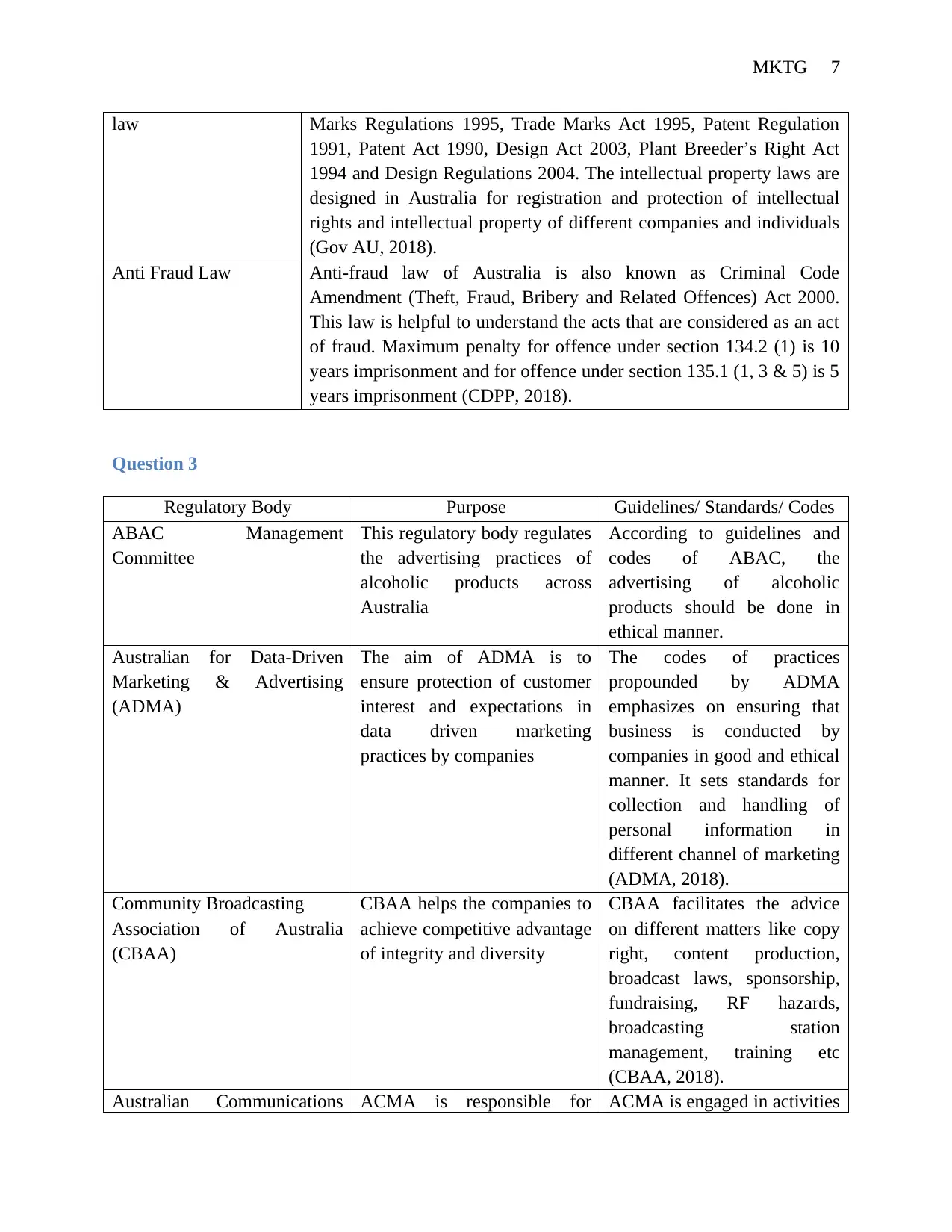
MKTG 7
law Marks Regulations 1995, Trade Marks Act 1995, Patent Regulation
1991, Patent Act 1990, Design Act 2003, Plant Breeder’s Right Act
1994 and Design Regulations 2004. The intellectual property laws are
designed in Australia for registration and protection of intellectual
rights and intellectual property of different companies and individuals
(Gov AU, 2018).
Anti Fraud Law Anti-fraud law of Australia is also known as Criminal Code
Amendment (Theft, Fraud, Bribery and Related Offences) Act 2000.
This law is helpful to understand the acts that are considered as an act
of fraud. Maximum penalty for offence under section 134.2 (1) is 10
years imprisonment and for offence under section 135.1 (1, 3 & 5) is 5
years imprisonment (CDPP, 2018).
Question 3
Regulatory Body Purpose Guidelines/ Standards/ Codes
ABAC Management
Committee
This regulatory body regulates
the advertising practices of
alcoholic products across
Australia
According to guidelines and
codes of ABAC, the
advertising of alcoholic
products should be done in
ethical manner.
Australian for Data-Driven
Marketing & Advertising
(ADMA)
The aim of ADMA is to
ensure protection of customer
interest and expectations in
data driven marketing
practices by companies
The codes of practices
propounded by ADMA
emphasizes on ensuring that
business is conducted by
companies in good and ethical
manner. It sets standards for
collection and handling of
personal information in
different channel of marketing
(ADMA, 2018).
Community Broadcasting
Association of Australia
(CBAA)
CBAA helps the companies to
achieve competitive advantage
of integrity and diversity
CBAA facilitates the advice
on different matters like copy
right, content production,
broadcast laws, sponsorship,
fundraising, RF hazards,
broadcasting station
management, training etc
(CBAA, 2018).
Australian Communications ACMA is responsible for ACMA is engaged in activities
law Marks Regulations 1995, Trade Marks Act 1995, Patent Regulation
1991, Patent Act 1990, Design Act 2003, Plant Breeder’s Right Act
1994 and Design Regulations 2004. The intellectual property laws are
designed in Australia for registration and protection of intellectual
rights and intellectual property of different companies and individuals
(Gov AU, 2018).
Anti Fraud Law Anti-fraud law of Australia is also known as Criminal Code
Amendment (Theft, Fraud, Bribery and Related Offences) Act 2000.
This law is helpful to understand the acts that are considered as an act
of fraud. Maximum penalty for offence under section 134.2 (1) is 10
years imprisonment and for offence under section 135.1 (1, 3 & 5) is 5
years imprisonment (CDPP, 2018).
Question 3
Regulatory Body Purpose Guidelines/ Standards/ Codes
ABAC Management
Committee
This regulatory body regulates
the advertising practices of
alcoholic products across
Australia
According to guidelines and
codes of ABAC, the
advertising of alcoholic
products should be done in
ethical manner.
Australian for Data-Driven
Marketing & Advertising
(ADMA)
The aim of ADMA is to
ensure protection of customer
interest and expectations in
data driven marketing
practices by companies
The codes of practices
propounded by ADMA
emphasizes on ensuring that
business is conducted by
companies in good and ethical
manner. It sets standards for
collection and handling of
personal information in
different channel of marketing
(ADMA, 2018).
Community Broadcasting
Association of Australia
(CBAA)
CBAA helps the companies to
achieve competitive advantage
of integrity and diversity
CBAA facilitates the advice
on different matters like copy
right, content production,
broadcast laws, sponsorship,
fundraising, RF hazards,
broadcasting station
management, training etc
(CBAA, 2018).
Australian Communications ACMA is responsible for ACMA is engaged in activities
Paraphrase This Document
Need a fresh take? Get an instant paraphrase of this document with our AI Paraphraser
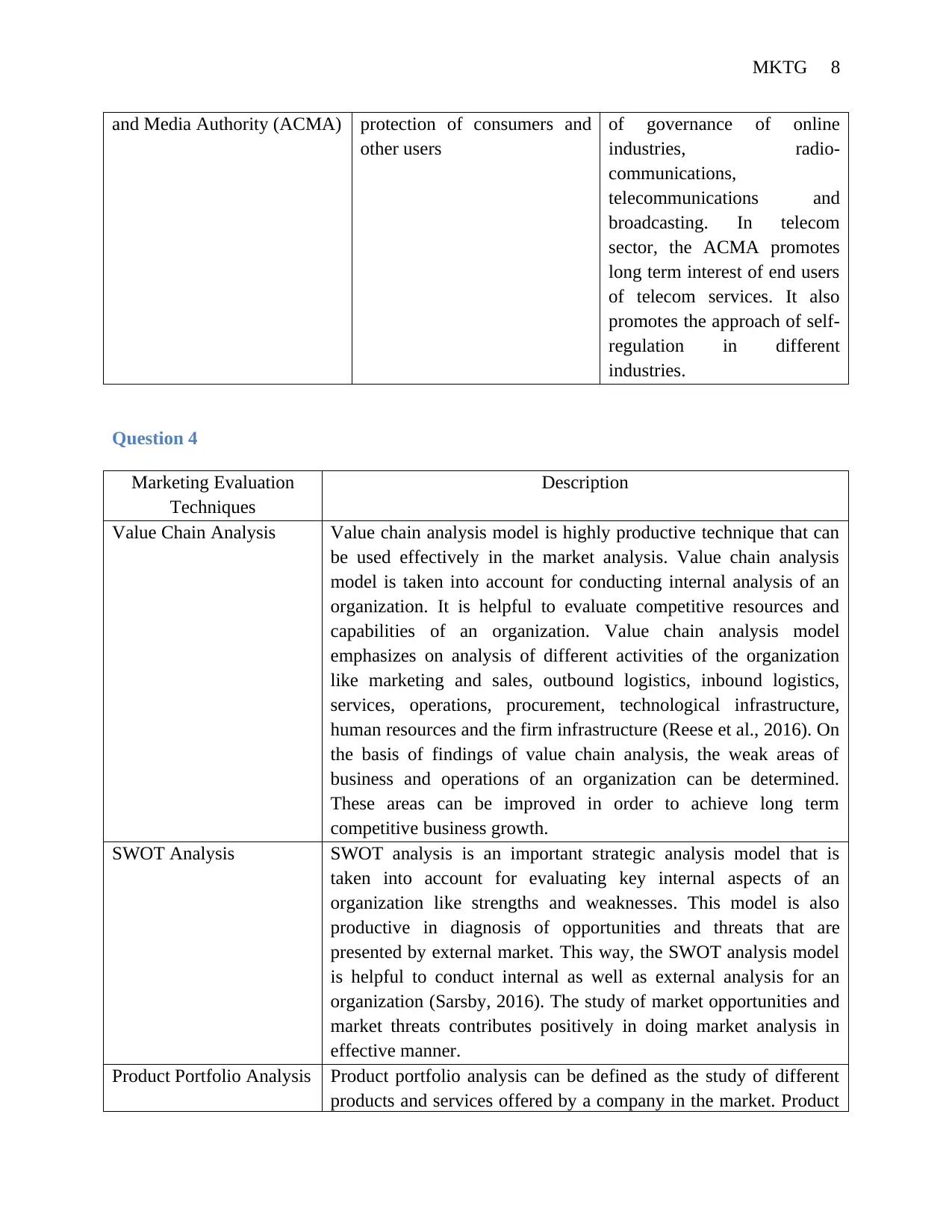
MKTG 8
and Media Authority (ACMA) protection of consumers and
other users
of governance of online
industries, radio-
communications,
telecommunications and
broadcasting. In telecom
sector, the ACMA promotes
long term interest of end users
of telecom services. It also
promotes the approach of self-
regulation in different
industries.
Question 4
Marketing Evaluation
Techniques
Description
Value Chain Analysis Value chain analysis model is highly productive technique that can
be used effectively in the market analysis. Value chain analysis
model is taken into account for conducting internal analysis of an
organization. It is helpful to evaluate competitive resources and
capabilities of an organization. Value chain analysis model
emphasizes on analysis of different activities of the organization
like marketing and sales, outbound logistics, inbound logistics,
services, operations, procurement, technological infrastructure,
human resources and the firm infrastructure (Reese et al., 2016). On
the basis of findings of value chain analysis, the weak areas of
business and operations of an organization can be determined.
These areas can be improved in order to achieve long term
competitive business growth.
SWOT Analysis SWOT analysis is an important strategic analysis model that is
taken into account for evaluating key internal aspects of an
organization like strengths and weaknesses. This model is also
productive in diagnosis of opportunities and threats that are
presented by external market. This way, the SWOT analysis model
is helpful to conduct internal as well as external analysis for an
organization (Sarsby, 2016). The study of market opportunities and
market threats contributes positively in doing market analysis in
effective manner.
Product Portfolio Analysis Product portfolio analysis can be defined as the study of different
products and services offered by a company in the market. Product
and Media Authority (ACMA) protection of consumers and
other users
of governance of online
industries, radio-
communications,
telecommunications and
broadcasting. In telecom
sector, the ACMA promotes
long term interest of end users
of telecom services. It also
promotes the approach of self-
regulation in different
industries.
Question 4
Marketing Evaluation
Techniques
Description
Value Chain Analysis Value chain analysis model is highly productive technique that can
be used effectively in the market analysis. Value chain analysis
model is taken into account for conducting internal analysis of an
organization. It is helpful to evaluate competitive resources and
capabilities of an organization. Value chain analysis model
emphasizes on analysis of different activities of the organization
like marketing and sales, outbound logistics, inbound logistics,
services, operations, procurement, technological infrastructure,
human resources and the firm infrastructure (Reese et al., 2016). On
the basis of findings of value chain analysis, the weak areas of
business and operations of an organization can be determined.
These areas can be improved in order to achieve long term
competitive business growth.
SWOT Analysis SWOT analysis is an important strategic analysis model that is
taken into account for evaluating key internal aspects of an
organization like strengths and weaknesses. This model is also
productive in diagnosis of opportunities and threats that are
presented by external market. This way, the SWOT analysis model
is helpful to conduct internal as well as external analysis for an
organization (Sarsby, 2016). The study of market opportunities and
market threats contributes positively in doing market analysis in
effective manner.
Product Portfolio Analysis Product portfolio analysis can be defined as the study of different
products and services offered by a company in the market. Product
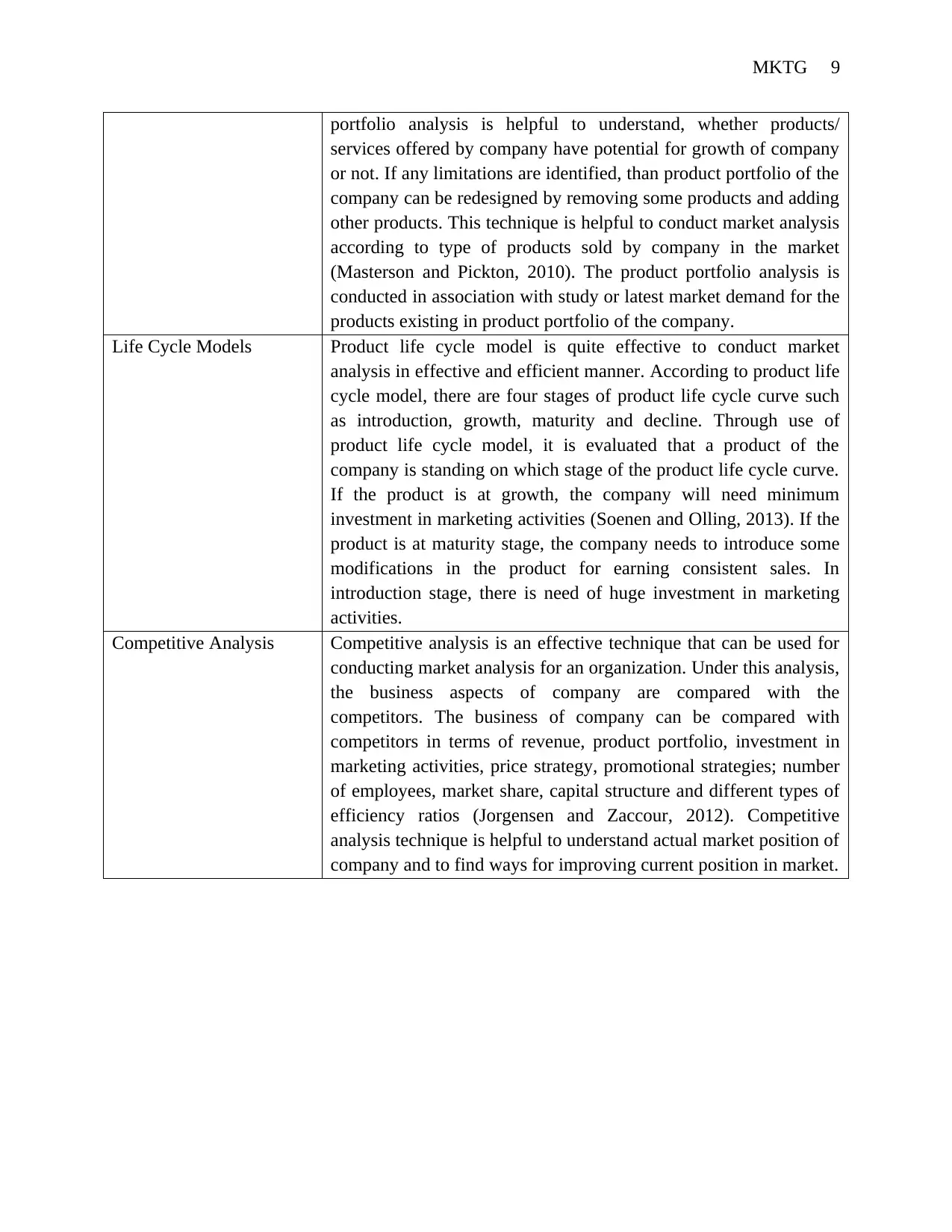
MKTG 9
portfolio analysis is helpful to understand, whether products/
services offered by company have potential for growth of company
or not. If any limitations are identified, than product portfolio of the
company can be redesigned by removing some products and adding
other products. This technique is helpful to conduct market analysis
according to type of products sold by company in the market
(Masterson and Pickton, 2010). The product portfolio analysis is
conducted in association with study or latest market demand for the
products existing in product portfolio of the company.
Life Cycle Models Product life cycle model is quite effective to conduct market
analysis in effective and efficient manner. According to product life
cycle model, there are four stages of product life cycle curve such
as introduction, growth, maturity and decline. Through use of
product life cycle model, it is evaluated that a product of the
company is standing on which stage of the product life cycle curve.
If the product is at growth, the company will need minimum
investment in marketing activities (Soenen and Olling, 2013). If the
product is at maturity stage, the company needs to introduce some
modifications in the product for earning consistent sales. In
introduction stage, there is need of huge investment in marketing
activities.
Competitive Analysis Competitive analysis is an effective technique that can be used for
conducting market analysis for an organization. Under this analysis,
the business aspects of company are compared with the
competitors. The business of company can be compared with
competitors in terms of revenue, product portfolio, investment in
marketing activities, price strategy, promotional strategies; number
of employees, market share, capital structure and different types of
efficiency ratios (Jorgensen and Zaccour, 2012). Competitive
analysis technique is helpful to understand actual market position of
company and to find ways for improving current position in market.
portfolio analysis is helpful to understand, whether products/
services offered by company have potential for growth of company
or not. If any limitations are identified, than product portfolio of the
company can be redesigned by removing some products and adding
other products. This technique is helpful to conduct market analysis
according to type of products sold by company in the market
(Masterson and Pickton, 2010). The product portfolio analysis is
conducted in association with study or latest market demand for the
products existing in product portfolio of the company.
Life Cycle Models Product life cycle model is quite effective to conduct market
analysis in effective and efficient manner. According to product life
cycle model, there are four stages of product life cycle curve such
as introduction, growth, maturity and decline. Through use of
product life cycle model, it is evaluated that a product of the
company is standing on which stage of the product life cycle curve.
If the product is at growth, the company will need minimum
investment in marketing activities (Soenen and Olling, 2013). If the
product is at maturity stage, the company needs to introduce some
modifications in the product for earning consistent sales. In
introduction stage, there is need of huge investment in marketing
activities.
Competitive Analysis Competitive analysis is an effective technique that can be used for
conducting market analysis for an organization. Under this analysis,
the business aspects of company are compared with the
competitors. The business of company can be compared with
competitors in terms of revenue, product portfolio, investment in
marketing activities, price strategy, promotional strategies; number
of employees, market share, capital structure and different types of
efficiency ratios (Jorgensen and Zaccour, 2012). Competitive
analysis technique is helpful to understand actual market position of
company and to find ways for improving current position in market.
⊘ This is a preview!⊘
Do you want full access?
Subscribe today to unlock all pages.

Trusted by 1+ million students worldwide
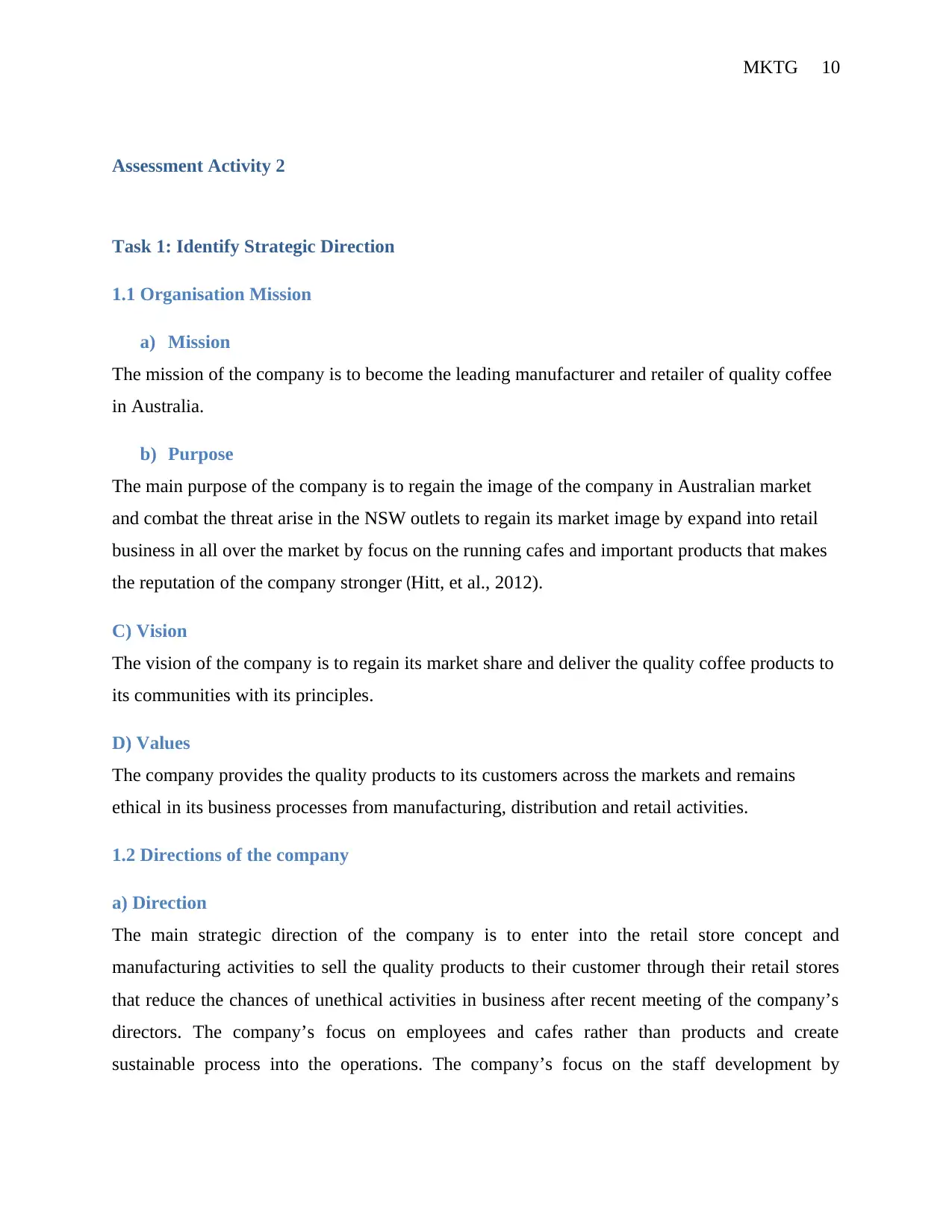
MKTG 10
Assessment Activity 2
Task 1: Identify Strategic Direction
1.1 Organisation Mission
a) Mission
The mission of the company is to become the leading manufacturer and retailer of quality coffee
in Australia.
b) Purpose
The main purpose of the company is to regain the image of the company in Australian market
and combat the threat arise in the NSW outlets to regain its market image by expand into retail
business in all over the market by focus on the running cafes and important products that makes
the reputation of the company stronger (Hitt, et al., 2012).
C) Vision
The vision of the company is to regain its market share and deliver the quality coffee products to
its communities with its principles.
D) Values
The company provides the quality products to its customers across the markets and remains
ethical in its business processes from manufacturing, distribution and retail activities.
1.2 Directions of the company
a) Direction
The main strategic direction of the company is to enter into the retail store concept and
manufacturing activities to sell the quality products to their customer through their retail stores
that reduce the chances of unethical activities in business after recent meeting of the company’s
directors. The company’s focus on employees and cafes rather than products and create
sustainable process into the operations. The company’s focus on the staff development by
Assessment Activity 2
Task 1: Identify Strategic Direction
1.1 Organisation Mission
a) Mission
The mission of the company is to become the leading manufacturer and retailer of quality coffee
in Australia.
b) Purpose
The main purpose of the company is to regain the image of the company in Australian market
and combat the threat arise in the NSW outlets to regain its market image by expand into retail
business in all over the market by focus on the running cafes and important products that makes
the reputation of the company stronger (Hitt, et al., 2012).
C) Vision
The vision of the company is to regain its market share and deliver the quality coffee products to
its communities with its principles.
D) Values
The company provides the quality products to its customers across the markets and remains
ethical in its business processes from manufacturing, distribution and retail activities.
1.2 Directions of the company
a) Direction
The main strategic direction of the company is to enter into the retail store concept and
manufacturing activities to sell the quality products to their customer through their retail stores
that reduce the chances of unethical activities in business after recent meeting of the company’s
directors. The company’s focus on employees and cafes rather than products and create
sustainable process into the operations. The company’s focus on the staff development by
Paraphrase This Document
Need a fresh take? Get an instant paraphrase of this document with our AI Paraphraser
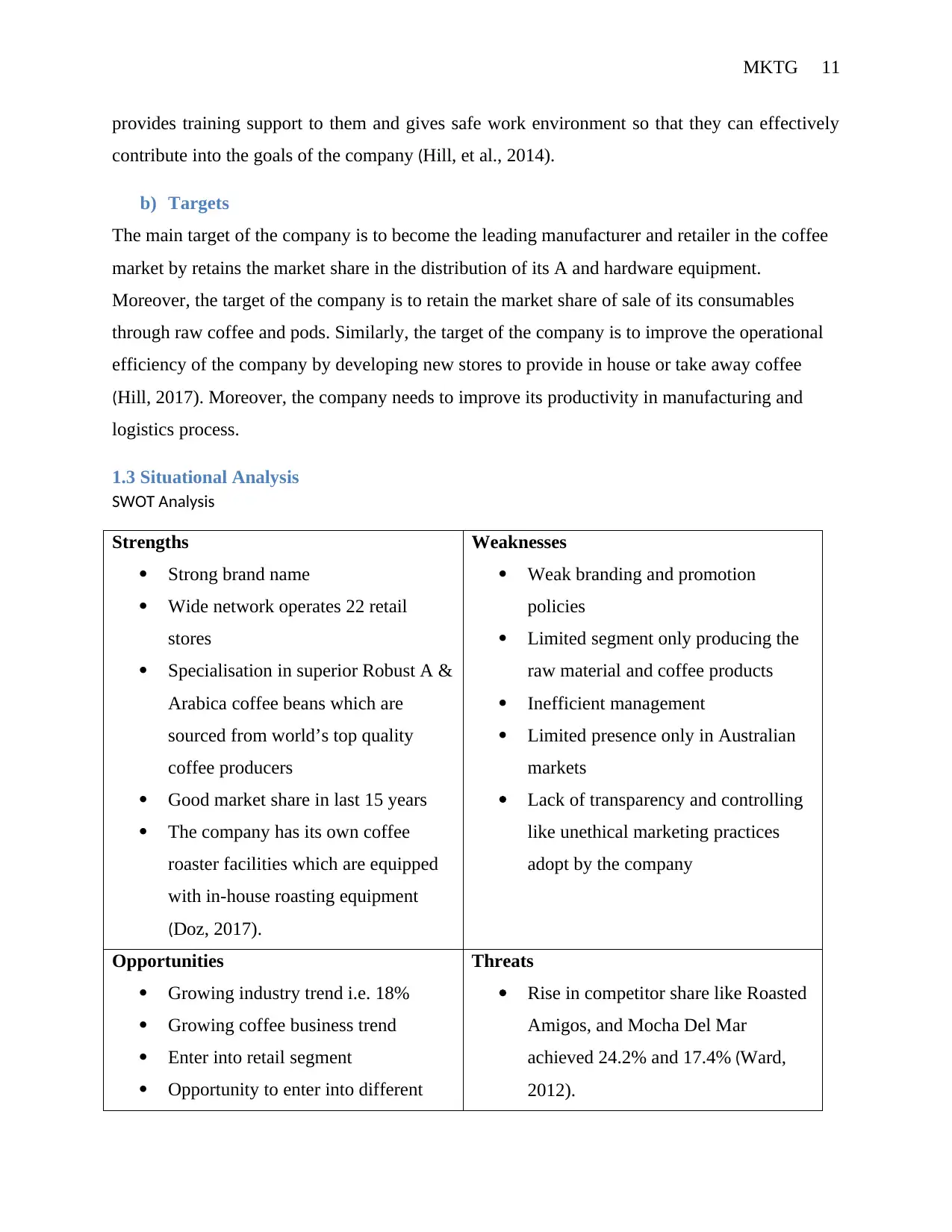
MKTG 11
provides training support to them and gives safe work environment so that they can effectively
contribute into the goals of the company (Hill, et al., 2014).
b) Targets
The main target of the company is to become the leading manufacturer and retailer in the coffee
market by retains the market share in the distribution of its A and hardware equipment.
Moreover, the target of the company is to retain the market share of sale of its consumables
through raw coffee and pods. Similarly, the target of the company is to improve the operational
efficiency of the company by developing new stores to provide in house or take away coffee
(Hill, 2017). Moreover, the company needs to improve its productivity in manufacturing and
logistics process.
1.3 Situational Analysis
SWOT Analysis
Strengths
Strong brand name
Wide network operates 22 retail
stores
Specialisation in superior Robust A &
Arabica coffee beans which are
sourced from world’s top quality
coffee producers
Good market share in last 15 years
The company has its own coffee
roaster facilities which are equipped
with in-house roasting equipment
(Doz, 2017).
Weaknesses
Weak branding and promotion
policies
Limited segment only producing the
raw material and coffee products
Inefficient management
Limited presence only in Australian
markets
Lack of transparency and controlling
like unethical marketing practices
adopt by the company
Opportunities
Growing industry trend i.e. 18%
Growing coffee business trend
Enter into retail segment
Opportunity to enter into different
Threats
Rise in competitor share like Roasted
Amigos, and Mocha Del Mar
achieved 24.2% and 17.4% (Ward,
2012).
provides training support to them and gives safe work environment so that they can effectively
contribute into the goals of the company (Hill, et al., 2014).
b) Targets
The main target of the company is to become the leading manufacturer and retailer in the coffee
market by retains the market share in the distribution of its A and hardware equipment.
Moreover, the target of the company is to retain the market share of sale of its consumables
through raw coffee and pods. Similarly, the target of the company is to improve the operational
efficiency of the company by developing new stores to provide in house or take away coffee
(Hill, 2017). Moreover, the company needs to improve its productivity in manufacturing and
logistics process.
1.3 Situational Analysis
SWOT Analysis
Strengths
Strong brand name
Wide network operates 22 retail
stores
Specialisation in superior Robust A &
Arabica coffee beans which are
sourced from world’s top quality
coffee producers
Good market share in last 15 years
The company has its own coffee
roaster facilities which are equipped
with in-house roasting equipment
(Doz, 2017).
Weaknesses
Weak branding and promotion
policies
Limited segment only producing the
raw material and coffee products
Inefficient management
Limited presence only in Australian
markets
Lack of transparency and controlling
like unethical marketing practices
adopt by the company
Opportunities
Growing industry trend i.e. 18%
Growing coffee business trend
Enter into retail segment
Opportunity to enter into different
Threats
Rise in competitor share like Roasted
Amigos, and Mocha Del Mar
achieved 24.2% and 17.4% (Ward,
2012).
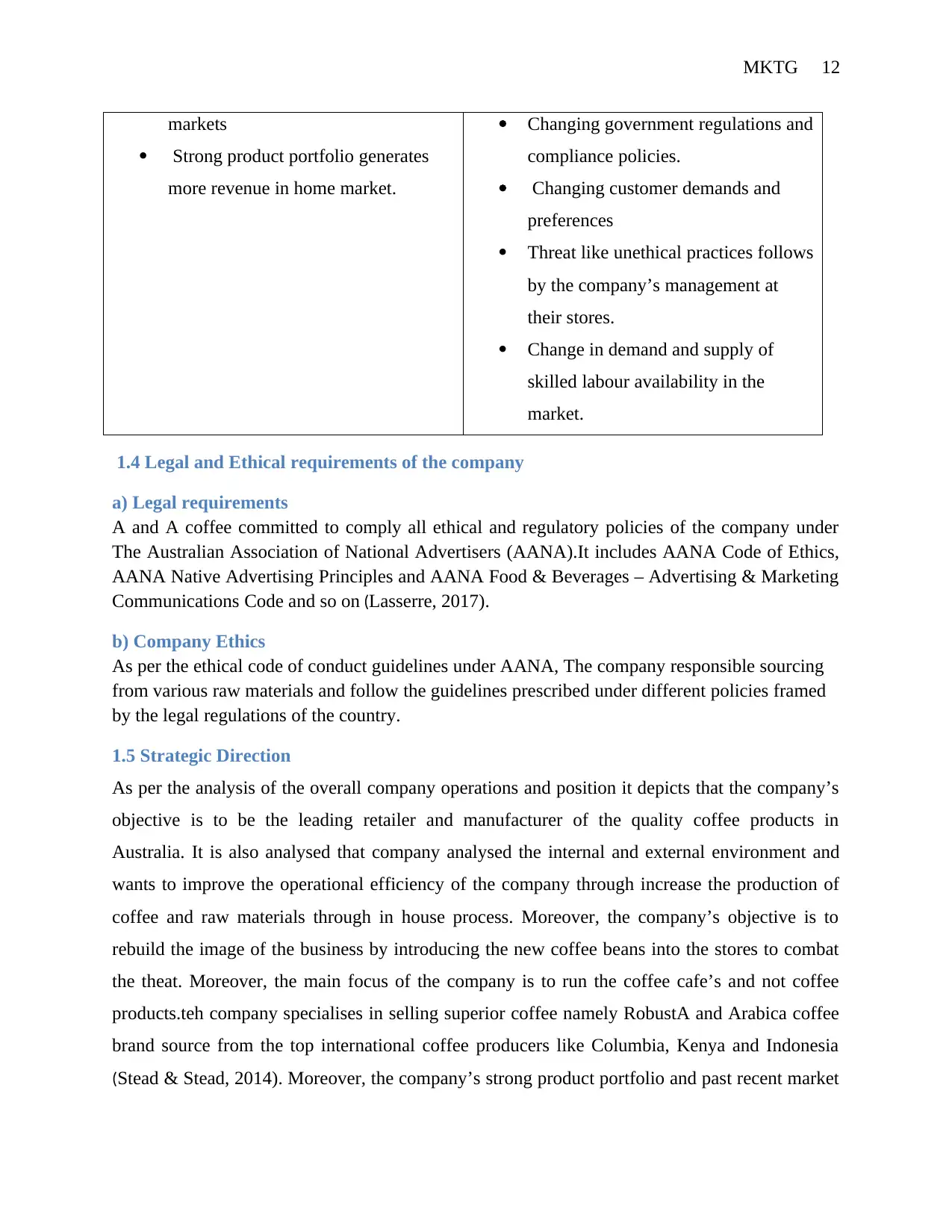
MKTG 12
markets
Strong product portfolio generates
more revenue in home market.
Changing government regulations and
compliance policies.
Changing customer demands and
preferences
Threat like unethical practices follows
by the company’s management at
their stores.
Change in demand and supply of
skilled labour availability in the
market.
1.4 Legal and Ethical requirements of the company
a) Legal requirements
A and A coffee committed to comply all ethical and regulatory policies of the company under
The Australian Association of National Advertisers (AANA).It includes AANA Code of Ethics,
AANA Native Advertising Principles and AANA Food & Beverages – Advertising & Marketing
Communications Code and so on (Lasserre, 2017).
b) Company Ethics
As per the ethical code of conduct guidelines under AANA, The company responsible sourcing
from various raw materials and follow the guidelines prescribed under different policies framed
by the legal regulations of the country.
1.5 Strategic Direction
As per the analysis of the overall company operations and position it depicts that the company’s
objective is to be the leading retailer and manufacturer of the quality coffee products in
Australia. It is also analysed that company analysed the internal and external environment and
wants to improve the operational efficiency of the company through increase the production of
coffee and raw materials through in house process. Moreover, the company’s objective is to
rebuild the image of the business by introducing the new coffee beans into the stores to combat
the theat. Moreover, the main focus of the company is to run the coffee cafe’s and not coffee
products.teh company specialises in selling superior coffee namely RobustA and Arabica coffee
brand source from the top international coffee producers like Columbia, Kenya and Indonesia
(Stead & Stead, 2014). Moreover, the company’s strong product portfolio and past recent market
markets
Strong product portfolio generates
more revenue in home market.
Changing government regulations and
compliance policies.
Changing customer demands and
preferences
Threat like unethical practices follows
by the company’s management at
their stores.
Change in demand and supply of
skilled labour availability in the
market.
1.4 Legal and Ethical requirements of the company
a) Legal requirements
A and A coffee committed to comply all ethical and regulatory policies of the company under
The Australian Association of National Advertisers (AANA).It includes AANA Code of Ethics,
AANA Native Advertising Principles and AANA Food & Beverages – Advertising & Marketing
Communications Code and so on (Lasserre, 2017).
b) Company Ethics
As per the ethical code of conduct guidelines under AANA, The company responsible sourcing
from various raw materials and follow the guidelines prescribed under different policies framed
by the legal regulations of the country.
1.5 Strategic Direction
As per the analysis of the overall company operations and position it depicts that the company’s
objective is to be the leading retailer and manufacturer of the quality coffee products in
Australia. It is also analysed that company analysed the internal and external environment and
wants to improve the operational efficiency of the company through increase the production of
coffee and raw materials through in house process. Moreover, the company’s objective is to
rebuild the image of the business by introducing the new coffee beans into the stores to combat
the theat. Moreover, the main focus of the company is to run the coffee cafe’s and not coffee
products.teh company specialises in selling superior coffee namely RobustA and Arabica coffee
brand source from the top international coffee producers like Columbia, Kenya and Indonesia
(Stead & Stead, 2014). Moreover, the company’s strong product portfolio and past recent market
⊘ This is a preview!⊘
Do you want full access?
Subscribe today to unlock all pages.

Trusted by 1+ million students worldwide
1 out of 23
Related Documents
Your All-in-One AI-Powered Toolkit for Academic Success.
+13062052269
info@desklib.com
Available 24*7 on WhatsApp / Email
![[object Object]](/_next/static/media/star-bottom.7253800d.svg)
Unlock your academic potential
Copyright © 2020–2025 A2Z Services. All Rights Reserved. Developed and managed by ZUCOL.




